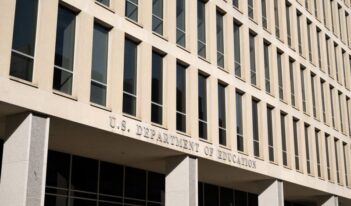
Experts examine and propose policy changes to address U.S. teacher attrition.
Following the rise of another COVID-19 surge during the holiday season, many schools started the new calendar year scrambling to fill teaching positions. New Mexico even deployed National Guard troops to classrooms to volunteer as substitute teachers amid crippling school staffing shortages.
Last month, the Biden Administration announced plans to make an additional 10 million COVID-19 tests per month available to schools nationwide. Many teachers applauded the Administration for taking steps to ensure educator and student safety. At the same time, teachers nationwide opted not to return to their classrooms at the start of the semester due to COVID-19 infections and low morale.
To ameliorate teacher shortages, state policymakers across the country enacted emergency regulatory measures, such as expediting the teacher certification process and lowering the requirements for obtaining emergency substitute teaching licenses.
This is not the first time states have taken such measures. During the Great Recession, many states cut funding for K-12 education, leading to record teacher shortages. Several states remedied these shortages by expanding emergency permits to allow the hiring of uncertified teachers. But even with these measures in place, teacher shortages have remained a constant problem. In 2016, the Learning Policy Institute projected that there will be a deficit of more than 100,000 teachers by 2025.
The COVID-19 pandemic has exacerbated the issue further. As state and federal lawmakers shift their focus to the nation’s teacher shortage in light of the pandemic, they suggest that the issue can be resolved with key policy changes.
In this week’s Saturday Seminar, experts highlight proposed and enacted regulatory solutions aimed at resolving the nation’s teacher shortage.
- Although the dynamics of teacher shortages vary by state based on local labor market conditions, some policy solutions aimed at addressing such shortages “need to be national in nature,” contend Linda Darling-Hammond and Desiree Carver-Thomas of the Learning Policy Institute and Leib Sutcher of the Los Angeles Unified School District. In an article published in the Education Policy Analysis Archives, the authors suggest that federal policymakers should develop initiatives that seek to decrease teacher attrition rather than focusing solely on recruiting more teachers to address shortages nationwide. Specifically, they call for the creation of high-quality teacher preparation programs, well-designed mentoring programs, and the improvement of overall working conditions for teachers.
- In an article published in the Washington University Law Review, Derek W. Black of the University of South Carolina School of Law highlights how states’ school funding cuts caused extreme teacher shortages in the wake of the Great Recession. Black argues that such shortages, along with other trends, changed the trajectory of educational adequacy litigation, which led to “the current under-enforcement of education rights and duties.” To remedy these issues, Black suggests that state courts should bolster their deterrence of education-based constitutional violations, adopt clearer rules for state educational entities, and encourage such entities to adopt affirmative policies to promote educational adequacy.
- In an article published in the Brigham Young University Education and Law Journal, Joseph H. Hanks and his coauthors from Brigham Young University identify key factors that are most predictive of teacher attrition. After analyzing survey data from practicing teachers, they report that teachers’ decisions to leave the profession are most influenced by their career goals and workplace dissatisfaction. Inadequate salary was only the third most important factor. In light of these findings, Hanks and his coauthors caution that “simplistic, one-dimensional approaches”—such as moderately increasing salaries—will not solve the teacher shortage without other policy changes. They urge legislators to rely on educational research when crafting new policies.
- In a policy proposal for The Hamilton Project, Thomas S. Dee of Stanford University and Dan Goldhaber of the University of Washington argue that the teacher shortage crisis is misunderstood. They explain that shortages are not evenly distributed across all subject areas but instead are concentrated in special education and STEM fields. In addition, schools in rural or economically disadvantaged areas are more likely to struggle with staffing. Dee and Goldhaber suggest that policymakers should target these high-need areas with increased compensation and alternative licensure programs.
- Retirement benefit enhancements for public school teachers may have more impact if they strengthen retention incentives for more novice teachers, argue Cory Koedel and Brett Xiang of the University of Missouri in a working paper for the National Center for Analysis of Longitudinal Data in Education Research. Koedel and Xiang studied the impact of a St. Louis Public School Retirement System percentage increase in pension wealth on the retention of teachers in the school system. The authors observed that the increases benefitted senior teachers the most and more novice teachers the least. They also found largely no increase in retention rates in response to the program. Koedel and Xiang posit that senior teachers already have the highest retention rates and that the policy may have increased retention rates if it had provided higher incentives to more novice groups of teachers.
- Classroom conditions are an important but overlooked factor in teacher attrition rates, argue Gabriela Ramos, assistant principal of Tavan Elementary School, and Thomas Hughes of Northern Arizona University in an article for the eJournal of Education Policy. Ramos and Hughes analyze a survey of parents and teachers within an Arizona public school district. They find that the teachers’ decisions to leave the school district are linked to personal stressors, such as disruptive student behavior, but administrators either are unaware of or refuse to recognize the teachers’ frustrations until their exit interviews. Ramos and Hughes argue that administrators should take a more proactive approach through policies that address working conditions in order to improve teacher attrition rates.
The Saturday Seminar is a weekly feature that aims to put into written form the kind of content that would be conveyed in a live seminar involving regulatory experts. Each week, The Regulatory Review publishes a brief overview of a selected regulatory topic and then distills recent research and scholarly writing on that topic.



